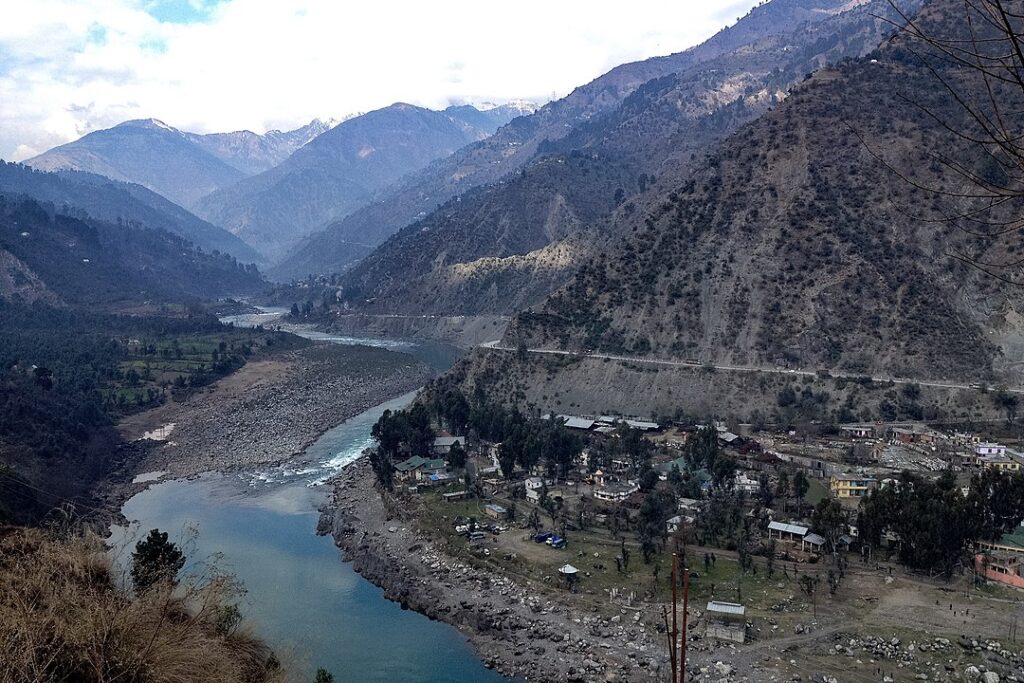Chenab River
The Chenab River is one of the major rivers of the Indus River System, flowing through India and Pakistan. It holds significant geographical, cultural, and economic importance, particularly for the regions it traverses. Here’s a detailed overview of the Chenab River:

Geographical Origin and Course
The Chenab River originates from the Baralacha Pass in the Lahaul-Spiti region of Himachal Pradesh, India. It is formed by the confluence of two rivers: the Chandra River and the Bhaga River, hence the name “Chenab” (from the Sanskrit words Chandra and Bhaga). After flowing through Himachal Pradesh, the Chenab enters the Jammu region of Jammu and Kashmir, flowing through the Pangi Valley and Doda district.
The river then flows westward into Pakistan-administered Kashmir, eventually entering the plains of the Punjab province in Pakistan. In Pakistan, it merges with the Jhelum River and then meets the Sutlej River before finally joining the Indus River, which flows into the Arabian Sea.
Length
The total length of the Chenab River is approximately 960 kilometers.
Tributaries
Some of the important tributaries of the Chenab include the Tawi, Ravi, and Marusudar rivers.
Historical and Cultural Importance
The Chenab River has been mentioned in several ancient texts and historical records, especially those related to the Indus Valley Civilization and the Vedic period. It is also significant in Sikhism and Islamic history. Several cities and religious sites along its course hold historical importance.
Economic Importance
The Chenab River is vital for irrigation and agriculture, particularly in the fertile plains of Punjab, Pakistan, where it supports the cultivation of wheat, rice, and other crops. Several canals have been constructed to divert water from the Chenab to irrigate the region’s agricultural lands.
Hydroelectric Projects
The Chenab River is harnessed for hydroelectric power generation, especially in India. Some major projects include:
- Baglihar Dam: A significant hydroelectric project located on the Chenab in Jammu and Kashmir.
- Salal Dam: Another major project that generates hydroelectricity and helps with flood control.
These projects are crucial for meeting the energy demands of the region, though they have also been a point of contention between India and Pakistan.
Indus Water Treaty (1960)
The Indus Water Treaty between India and Pakistan governs the use of the rivers in the Indus Basin, including the Chenab. Under the treaty, Pakistan has control over the Chenab River, but India is allowed limited use of its waters for irrigation, hydroelectric power, and other non-consumptive purposes. The construction of dams and hydroelectric projects on the Chenab has occasionally led to disputes between India and Pakistan, with Pakistan expressing concerns about water flow and availability.
Environmental Significance
The Chenab River is home to diverse ecosystems, including various species of fish and birds. It supports not only agriculture but also the biodiversity of the regions it flows through. However, the river faces challenges such as pollution, habitat destruction, and the impact of dam construction on its natural flow.
Flooding
The Chenab River is prone to seasonal flooding, especially during the monsoon season. These floods can cause extensive damage to crops, infrastructure, and settlements along its course, particularly in Pakistan’s Punjab region.
Mythological and Cultural Associations
In Punjabi folklore, the Chenab River is associated with the tragic love story of Sohni and Mahiwal, a famous tale of love and sacrifice, often compared to Romeo and Juliet. The river also finds mention in poetry, literature, and songs, reflecting its deep cultural connection with the people of the region.
The Chenab River plays a critical role in the lives of millions of people, particularly in northern India and Pakistan. Its waters support agriculture, generate hydroelectric power, and serve as a lifeline for the regions it flows through. At the same time, it holds immense historical, cultural, and religious significance, making it one of the most important rivers in the Indian subcontinent.



2 Responses
[…] tributaries (part of the Punjab rivers): Jhelum, Chenab, Ravi, Beas, and […]
[…] water for irrigation. The Sutlej then crosses into Punjab in Pakistan, where it merges with the Chenab River and ultimately joins the Indus River. The river eventually empties into the Arabian […]